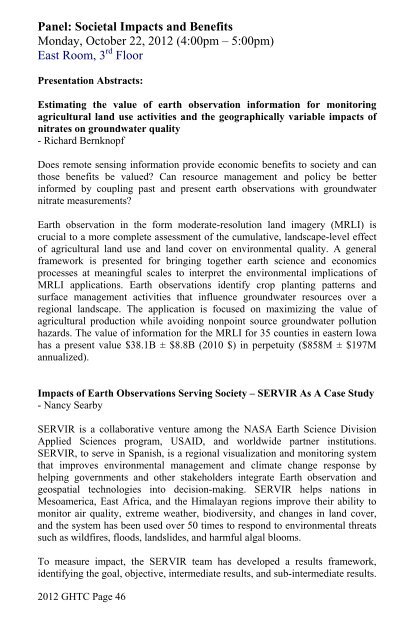the Program Booklet - IEEE Global Humanitarian Technology ...
the Program Booklet - IEEE Global Humanitarian Technology ...
the Program Booklet - IEEE Global Humanitarian Technology ...
Create successful ePaper yourself
Turn your PDF publications into a flip-book with our unique Google optimized e-Paper software.
Panel: Societal Impacts and Benefits<br />
Monday, October 22, 2012 (4:00pm – 5:00pm)<br />
East Room, 3 rd Floor<br />
Presentation Abstracts:<br />
Estimating <strong>the</strong> value of earth observation information for monitoring<br />
agricultural land use activities and <strong>the</strong> geographically variable impacts of<br />
nitrates on groundwater quality<br />
- Richard Bernknopf<br />
Does remote sensing information provide economic benefits to society and can<br />
those benefits be valued? Can resource management and policy be better<br />
informed by coupling past and present earth observations with groundwater<br />
nitrate measurements?<br />
Earth observation in <strong>the</strong> form moderate-resolution land imagery (MRLI) is<br />
crucial to a more complete assessment of <strong>the</strong> cumulative, landscape-level effect<br />
of agricultural land use and land cover on environmental quality. A general<br />
framework is presented for bringing toge<strong>the</strong>r earth science and economics<br />
processes at meaningful scales to interpret <strong>the</strong> environmental implications of<br />
MRLI applications. Earth observations identify crop planting patterns and<br />
surface management activities that influence groundwater resources over a<br />
regional landscape. The application is focused on maximizing <strong>the</strong> value of<br />
agricultural production while avoiding nonpoint source groundwater pollution<br />
hazards. The value of information for <strong>the</strong> MRLI for 35 counties in eastern Iowa<br />
has a present value $38.1B ± $8.8B (2010 $) in perpetuity ($858M ± $197M<br />
annualized).<br />
Impacts of Earth Observations Serving Society – SERVIR As A Case Study<br />
- Nancy Searby<br />
SERVIR is a collaborative venture among <strong>the</strong> NASA Earth Science Division<br />
Applied Sciences program, USAID, and worldwide partner institutions.<br />
SERVIR, to serve in Spanish, is a regional visualization and monitoring system<br />
that improves environmental management and climate change response by<br />
helping governments and o<strong>the</strong>r stakeholders integrate Earth observation and<br />
geospatial technologies into decision-making. SERVIR helps nations in<br />
Mesoamerica, East Africa, and <strong>the</strong> Himalayan regions improve <strong>the</strong>ir ability to<br />
monitor air quality, extreme wea<strong>the</strong>r, biodiversity, and changes in land cover,<br />
and <strong>the</strong> system has been used over 50 times to respond to environmental threats<br />
such as wildfires, floods, landslides, and harmful algal blooms.<br />
To measure impact, <strong>the</strong> SERVIR team has developed a results framework,<br />
identifying <strong>the</strong> goal, objective, intermediate results, and sub-intermediate results.<br />
2012 GHTC Page 46


